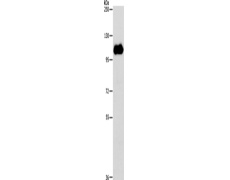中文名稱: 兔抗NOTCH1多克隆抗體
英文名稱: Anti-NOTCH1 rabbit polyclonal antibody
別 名: hN1, TAN1
相關(guān)類別: 一抗
儲(chǔ) 存: 冷凍(-20℃)
宿 主: Rabbit
抗 原: NOTCH1
反應(yīng)種屬: Human, Rat
標(biāo) 記 物: Unconjugate
克隆類型: rabbit polyclonal
技術(shù)規(guī)格
|
Background: |
This gene encodes a member of the Notch family. Members of this Type 1 transmembrane protein family share structural characteristics including an extracellular domain consisting of multiple epidermal growth factor-like (EGF) repeats, and an intracellular domain consisting of multiple, different domain types. Notch family members play a role in a variety of developmental processes by controlling cell fate decisions. The Notch signaling network is an evolutionarily conserved intercellular signaling pathway which regulates interactions between physically adjacent cells. In Drosophilia, notch interaction with its cell-bound ligands (delta, serrate) establishes an intercellular signaling pathway that plays a key role in development. Homologues of the notch-ligands have also been identified in human, but precise interactions between these ligands and the human notch homologues remain to be determined. This protein is cleaved in the trans-Golgi network, and presented on the cell surface as a heterodimer. This protein functions as a receptor for membrane bound ligands, and may play multiple roles during development. |
|
Applications: |
ELISA, WB, IHC |
|
Name of antibody: |
NOTCH1 |
|
Immunogen: |
Synthetic peptide of human NOTCH1 |
|
Full name: |
Notch 1 |
|
Synonyms: |
hN1, TAN1 |
|
SwissProt: |
P46531 |
|
ELISA Recommended dilution: |
2000-10000 |
|
IHC positive control: |
Human cervical cancer |
|
IHC Recommend dilution: |
50-200 |
|
WB Predicted band size: |
273 kDa |
|
WB Positive control: |
HT-29 cells |
|
WB Recommended dilution: |
500-2000 |


 購物車
購物車 幫助
幫助
 021-54845833/15800441009
021-54845833/15800441009

